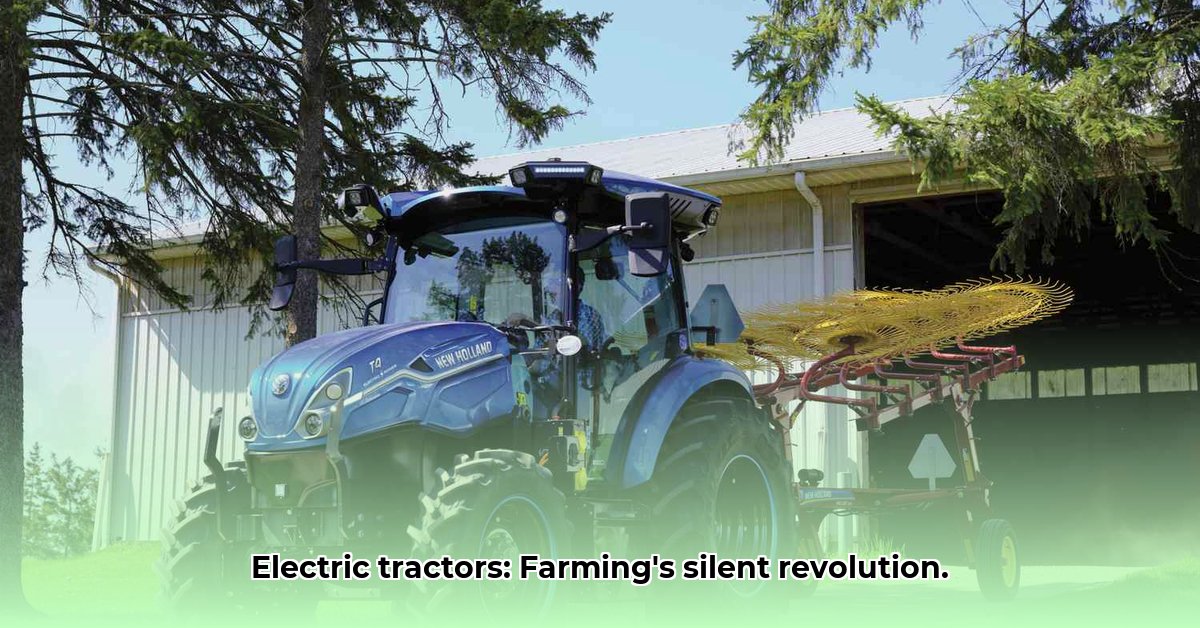
Powering a Greener Future: The Rise of Electric Utility Tractors
The agricultural landscape is undergoing a significant transformation, with electric utility tractors emerging as a key player in sustainable farming practices. Leading manufacturers like New Holland and Case IH are spearheading this shift, offering models such as the New Holland T4 Electric Power and the Case IH Farmall Utility 75C. These electric workhorses promise a quieter, cleaner, and potentially more efficient alternative to their diesel-fueled counterparts. But are they ready for prime time? This report analyzes the current state of electric utility tractors, examining their capabilities, limitations, and the factors driving their adoption. For more information on electric farm tractors, check out this helpful resource: Farmall Electric Tractors.
Power Play: A Comparative Look at Electric Tractor Models
Both the New Holland T4 Electric Power and the Case IH Farmall Utility 75C boast impressive specifications, delivering approximately 74 horsepower and 65 PTO horsepower – sufficient for many utility farming tasks. Top speeds reach around 25 mph, and standard features include a three-point hitch, rear PTO, and multiple hydraulic remotes. However, the key differentiator lies in the integration of advanced autonomous features. These include “follow me” modes, 360-degree cameras for enhanced visibility, and automated row following for precision planting and harvesting. The significant reduction in noise pollution is another notable advantage.
These tractors utilize DC fast charging, enabling a full charge in under an hour. However, current battery technology presents a significant limitation: operative run time. While manufacturers claim up to eight hours under lighter loads, a more realistic expectation for heavy use hovers around four hours. This limited range remains a major hurdle to overcome. How can we extend battery life without compromising power or cost?
The Economic Landscape: Cost Analysis and Infrastructure Needs
The total cost of ownership (TCO) remains a critical factor influencing adoption rates. While precise TCO comparisons with diesel tractors are challenging due to the relative novelty of electric models and the lack of long-term data, the initial investment is undeniably higher. The lifespan of electric tractor batteries, as well as the costs associated with their replacement and routine maintenance, are still uncertain. Addressing these uncertainties is vital for wider market penetration. What is the expected lifespan of current electric tractor batteries, and what are the projected costs of replacement?
Furthermore, the availability of charging infrastructure is crucial. Currently, accessible charging stations for farm equipment are not widely distributed. The development of a reliable and convenient charging network is paramount for electric tractor adoption. Will rural electrification initiatives and private investments adequately address the charging infrastructure shortfall?
Stakeholder Analysis: Impacts Across the Agricultural Ecosystem
The transition to electric utility tractors impacts numerous stakeholders:
| Stakeholder | Short-Term Impact | Long-Term Impact |
|---|---|---|
| Farmers (Early Adopters) | Higher initial investment; learning curve associated with new technology; exploration of financing. | Potential cost savings; improved efficiency; reduced environmental impact; enhanced brand image; increased productivity. |
| Manufacturers | Investment in battery technology and autonomous features development. | Diversification of product lines; focus on sustainable solutions; integration of renewable energy into charging solutions. |
| Government/Policy Makers | Subsidies and incentives for adoption; investment in rural charging infrastructure development. | Regulation of emissions; support for battery recycling programs; long-term planning for sustainable agricultural practices. |
| Energy Providers | Opportunities to provide specialized charging solutions to farms. | Integration of smart grids; exploration of on-farm renewable energy generation (solar, wind). |
The Road Ahead: Future Challenges and Opportunities
Widespread adoption of electric utility tractors hinges on several key factors. Significant breakthroughs in battery technology, extending both runtime and lifespan, are essential. Concurrently, the development of a robust and accessible charging infrastructure is critical. Finally, achieving cost parity or even a cost advantage compared to diesel tractors will be essential for widespread market acceptance.
Despite the challenges, the potential benefits are substantial. Reduced greenhouse gas emissions, quieter operation, and the promise of increased automation through advanced features make electric utility tractors a compelling investment. The next few years will be pivotal in determining the long-term success of this innovative technology. Will electric tractors revolutionize sustainable farming practices? Only time will tell, but the potential for a more environmentally friendly and efficient agricultural future is undeniable.
Calculating Total Cost of Ownership (TCO) for Electric Tractors: A Practical Guide
Understanding the true cost of ownership is crucial before purchasing an electric tractor. This involves a comprehensive assessment considering several key factors.
Key Factors for TCO Calculation:
- Purchase Price: The initial investment cost. (Often higher for electric).
- Depreciation: The annual decrease in value.
- Energy Costs: Electricity versus diesel fuel expenses. (Generally lower for electricity).
- Maintenance & Repairs: Routine servicing and potential repairs. (Often lower for electric).
- Battery Replacement: Cost and frequency of battery replacement. (Major cost factor).
- Charging Infrastructure: Investment in charging stations.
- Government Incentives: Potential subsidies and tax credits.
- Resale Value: The estimated resale value at the end of the tractor's useful life.
Step-by-Step TCO Calculation:
- Gather Data: Compile the costs for each of the above factors.
- Estimate Lifespan: Determine the expected operational life (years) for both the tractor and its battery.
- Calculate Annual Costs: Divide total costs (excluding purchase price) by lifespan to determine annual operational expenses.
- Calculate Annual Depreciation: Determine annual depreciation by dividing the purchase price by lifespan.
- Total Annual Cost: Add annual operational expenses and annual depreciation.
- Total Cost of Ownership (TCO): Multiply total annual cost by lifespan.
By following these steps and comparing the TCO of electric and diesel tractors, farmers can make data-driven decisions that align with their budget and long-term sustainability goals. Remember, the TCO is an estimate; unexpected repairs or changes in energy prices can influence the final cost. The environmental benefits, however, remain a crucial consideration in the long-term viability of this sustainable farming technology.